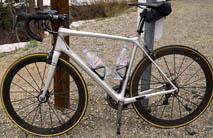Dehydration and Fluid Intake for Endurance Efforts
It’s important to monitor one’s weight before and after a long ride, in order to see how well one is staying hydrated.
It is not physically possible to stay hydrated under many riding conditions, because the body can lose up to 2 liters of fluid per hour (think 100°F and intense exercise), yet the body can absorb no more than about 1 liter per hour of fluid, even a fluid with an optimal mix of calories and electrolytes, which absorbs faster than plain water.
I have recently documented my own weight loss of as much as 8 pounds on a 5 hour ride— and that’s includes drinking 2 liters of water during the ride. Some of that is burned-off glycogen and fat on a 4000-calorie ride, but the bulk of it is fluid— water. My mistake? I should be drinking at least 3 liters for a 5 hour ride.
Today’s example
Today I forgot to weigh myself before my ride, but upon waking in the morning, I weighed 170.6 before eating and hydrating— figure at least 2 pounds of fluid and food for a likely weight of 172.6 prior to the afternoon ride, maybe a bit less, maybe a bit more.
After my 2:48 afternoon ride (an intense 2200 calorie effort), I weighed in at 165.8, which is 4.8 pounds less than morning weight! Meaning I was “down” by at least 5 pounds, or 5 pints of water (and probably more like 7 pints)! Those figures are consistent with other rides where I’ve carefully weighed myself before and after (and observed up to 8 pounds loss). As a 170-pound rider, that means I lost at least 2.9% of my body weight, which is beyond the point where performance begins to decline (I actually had my 2nd fastest ascent of the year near the end of the ride, but I felt overly tired, which was probably dehydration).
I was indeed getting thirsty by ride’s end, and I had taken and consumed only 1 liter of water with me, a big mistake (1-liter bottles are a critical need when water is not readily available, but if you only take one of them...).
Note that my consumption of 1 liter (34 oz) of water in 2:48 is 12 oz of water per hour, about 5 oz per hour less than the recommended amount. Bad boy. But I disagree (from experience) with the recommended 17 oz amount for the intensity and conditions I often ride in; it would be a disaster for an 8 hour ride. I need at least 25 oz per hour under hot conditions, and my past racing and training experience confirms that a full liter per hour (34 oz) is scarcely enough, but also all that my stomach can handle. So somewhere between 25 and 34 oz per hour for very hot and dry conditions should be tested for your individual physiology.
Everest Challenge
Hydration is likely to be my #1 challenge at the Everest Challenge. I’m concluding that my fluid intake must be monitored carefully to maximize input to 1L an hour (about a gallon for the first day), which is what I did in 2004, still ending up significantly dehydrated. Yet that worked very well— I was able to absorb it at that rate, and it was essential in the near 100° temps (I also took electrolyte supplements, and I’ve never had hyponatremia).




